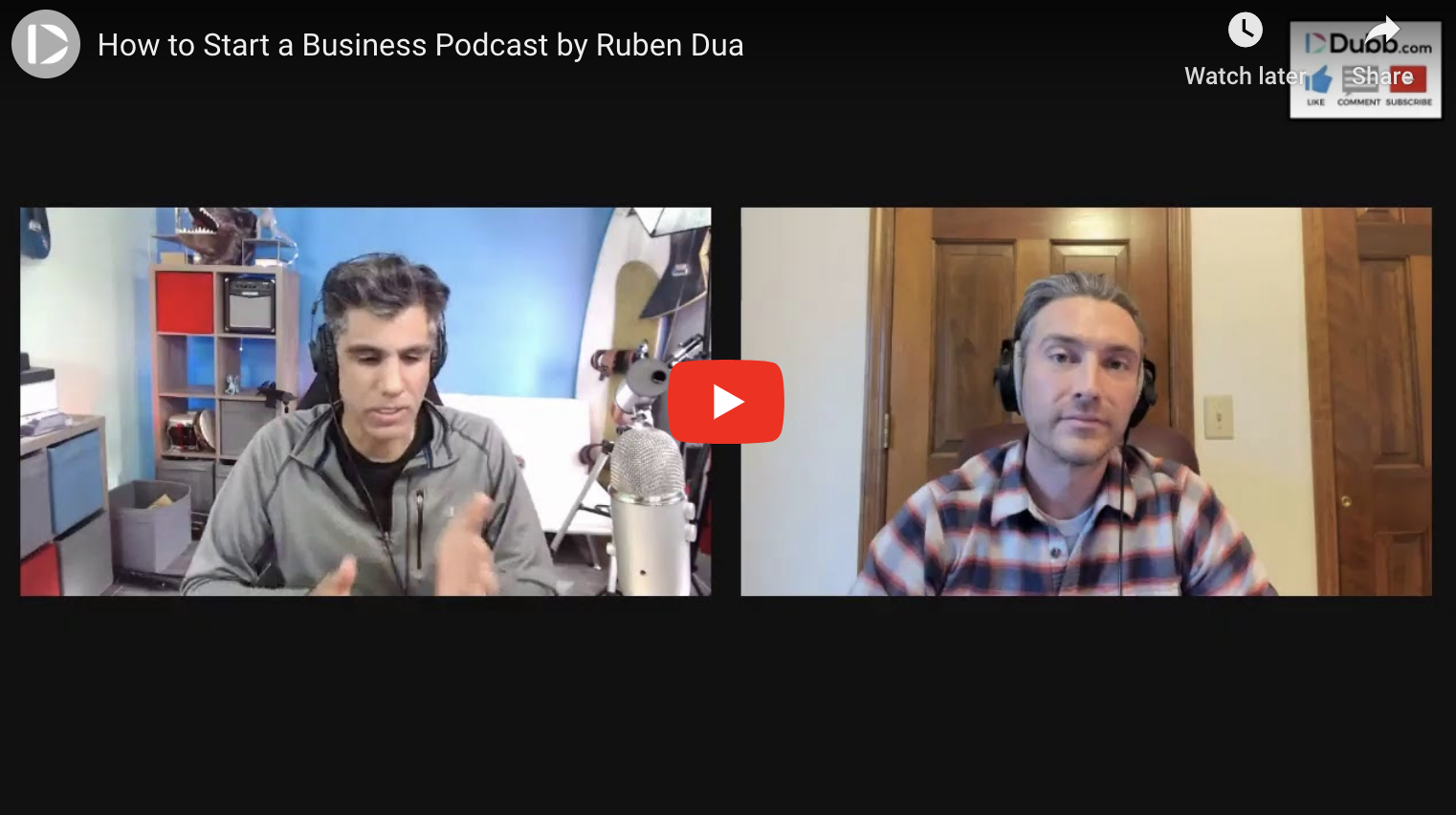With the rise of podcasting becoming well-known, many business owners and entrepreneurs are wondering how to start a business podcast. As a starting point, you are definitely onto something. According to a study from June 2020, there are over 850,000 active podcasts and over 30 million podcast episodes. While there are plenty of other creators leveraging this relatively old platform, there are still plenty of opportunities to create a successful podcast.
But like many things in life, theory is much different than execution. While you can definitely make a splash with your new business podcast, it isn’t guaranteed. Ultimately, it is going to require a significant and consistent effort from you and your colleagues.
The good news? It can be done. In this post, I want to share some of my favorite tips and strategies on how to start a business podcast. Starting Dubb’s podcast Connection Loop, I have certainly learned a lot about podcasting and how to scale a successful podcast. But along with my experience, I want to share some common tips and strategies that can help you accomplish all of your podcasting goals.
Are you ready? Let’s get you started on your podcasting journey.

Branding
To get started on this discussion of how to start a business podcast, we are going to talk about branding. This may not seem a natural place to begin a discussion of how to start a business podcast, yet it is extremely important. With so many business podcasts out there, you need to find a way to separate yourself.
No matter your niche or sector, there are ways that you can come up with a unique show for your audience. While it may take some work to get to that point, it is all worth it.
The First Question: What Is Your Mission?
Before you get into scheduling guests and choosing your podcasting equipment, there is one important question that you must answer.
That question is: what is your ultimate mission?
It seems like a straightforward question, but it can lead to some interesting results. Really, you are trying to get at the why of your podcast. Why should it exist? What are you trying to accomplish?
As just one example, let’s say that you just started a new SaaS company. You and your co-founders are busy building out the software, but you are looking for ways to spread the word about your new product. A business podcast can be a great way to show your knowledge of your industry and to meet noteworthy individuals in your sector. At the end of your episodes, you can certainly talk about your product. That being said, by discussing the latest news and interviewing interesting guests, you can build a sophisticated audience—some of which may be interested in becoming a customer.
There are plenty of other potential missions for your show. Your business podcast can be an easy way to update your current customers on the internal operations of your company. You can tell customer stories and offer customer testimonials in your show. Your podcast can even be a hub for current or prospective customers to learn more about your product or service. Or it can be an excellent way to build new relationships with other fascinating people.
As with many elements of how to start a business podcast, there are no hard and fast rules here. The most critical part is sitting down and actually determining your mission and why. In short, by focusing on your mission and your why, you will be much more likely to accomplish all of your podcasting goals. It lets you connect with your audience on a heart-to-heart level and lets you speak to the dream of what could be. Don’t forget this as you are planning or revamping your show.
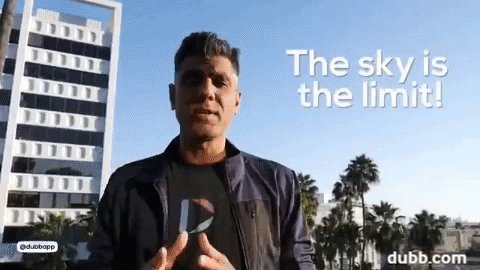
Monetization Plans
When talking about podcasts and monetization, some people may feel somewhat awkward. It may seem unethical, awkward, or unsavory. The reality, however, is that our time is valuable. Thinking about how to start a business podcast is easy, but actually starting and persisting is much tougher. Therefore, there’s nothing wrong with trying to achieve some sort of monetary compensation through your show.
Moreover, there is a way to monetize your podcast and provide massive value to your audience at the same time. Business podcasts often have some monetary goal in mind, but this doesn’t have to be your central mission. It can be an ancillary part of your show. That being said, the branding of any business podcast often intersects with your company’s business plan and go-to-market strategy.
For instance, part of your business plan or go-to-market strategy may be to find investors, co-founders, customers, and even new team members. All of these people can help you accomplish your business’s financial goals. Your podcast can be an excellent source of generating sales for a new product or service or even finding a game-changing employee.
Sure, you can generate some revenue by including advertising in your show. While you need a pretty substantial audience to see any meaningful revenue, this is an option. However, many business podcasters find that there are more attractive monetization opportunities compared to advertising.
Ultimately, think about your monetization strategy as you are planning your show. Even if your why is to better connect with your audience, there are so many great ways to monetize your show. It is in your financial interest to do so.
Determine Your Target Audience
Once you settle on your ultimate mission and potential monetization plan, you need to figure out the target audience for your podcast. This may seem like an obvious question when thinking about how to start a business podcast.
It’s your customers, right? Not always.
Your target audience may be prospective customers who have just heard about your company. Going one step further, that target audience could be prospects that have just heard about your organization. Your target audience may even be interested individuals who, at this moment, may not be interested in purchasing your product or service.
Having a deep understanding of your target audience is an essential part of building a great business podcast. Recognizing their problems, issues, and curiosities, you can create content that truly speaks to them. If you can solve this puzzle, your audience will reward you. They will become loyal listeners of your show and likely refer your podcast to their friends, family, and colleagues.
Whether you have already created your business podcast are in the early stages of doing so, make sure that you are laser-focused on your target audience. This is a mandatory exercise when thinking about how to start a business podcast. Failing at this exercise will cause your business podcast to remain stagnant. However, if you can identify your target audience and give them content that surprises and delights them, they will religiously tune in to your episodes.
Stay Consistent
Consistency may not be the first thing that comes to mind when thinking about your podcast’s branding. That said, I strongly believe that consistency is one of the most important parts of any business podcast.
Let’s face it: many podcasts don’t continue. While the hosts and founders may be extremely excited about their podcasting opportunity, they eventually stop doing it. It’s similar to that old adage that 80 to 90 percent of people give up.
There are plenty of reasons for this. Most prominent is the fact that business gets in the way. The host of the show may be the CEO of the company, meaning that he or she has one million other things on their plate. It can be easy to put the podcast “on a temporary hold,” but this often turns into a permanent hold.
So when creating your show, you need to keep consistency at the top of your mind. Do everything you can to release episodes on time. This is true whether you publish episodes every few days, every week, or every few weeks. Maintain a consistent cadence so that you can fulfill your audience’s expectations.
To do this, it’s important to return to the monetization discussion. Those business podcasters that give up often do so because they don’t see an attractive ROI from their show. If podcasting is taking them away from revenue generation, they likely aren’t going to stick with it. This is especially true in the early days (say, three episodes in). It’s much easier to conclude that podcasting is taking them away from their work, which will virtually ensure that the show will not scale.
Therefore, it’s critical to tie in some monetization strategy with your show. This monetization strategy can be short-term, medium-term, or long-term. Whatever it is, tying in some monetization strategy with your show will go a long way in helping you stay consistent. And by staying consistent, you will see more listeners and more traction for your show, which will help you stay even more consistent. A flywheel effect occurs and this effect will accelerate you toward your podcasting goals.
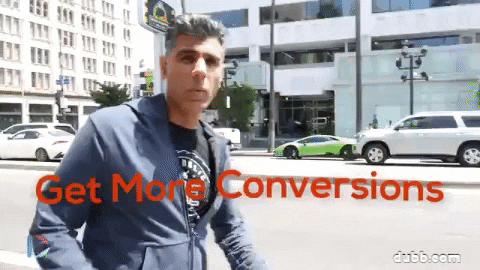
Coordination
Branding is an extremely important part when thinking about how to start a business podcast. It isn’t the only part, however. Another critical component of the business podcasting process is recording and coordinating your episodes.
In this subsection, we are going to focus on coordination related to your guests. In all likelihood, your podcast is going to have guests for every episode. While you can break this “rule” if you want, I have found that inviting guests on my show provides so many benefits. Not only do you get to learn from fascinating people inside and outside your industry, but you get to work with your guest to spread the word about your show.
If you are on the fence, I highly recommend that you incorporate guests into your podcasting content. While the logistics may seem intimidating at first, you will see that they aren’t as daunting as you may think.
Finding and Prospecting Guests
The first part of coordinating guests is deciding who you want to be on your show. Because this podcast is truly your own, you can go so many different ways with this. At the most basic level, you can start off by interviewing some of your colleagues. This is an easy way to find guests if you are struggling in the beginning. If you have just launched your show, you may not have that many options for potential guests. Essentially, many guests want to see at least some traction with your show before they decide to appear. In these situations, don’t hesitate to pick out someone that is sold on you and not your audience.
Once you have gained some traction, you can interview thought leaders in your sector, current customers, or even fascinating individuals who may not be in your industry. One great way to use your podcast is to speak with individuals that would normally be difficult to contact. By this, I mean those thought leaders, professionals, and investors that have extremely busy schedules. It is much easier reaching those hard-to-reach people by inviting them on your podcast.
The more successful or seasoned that a person is, the more expensive their time is. If you approached him or her and asked to grab a quick coffee, you may face steep odds. However, if you invite them to appear on your podcast, your odds have likely gotten better. Even if it would take longer than your coffee meeting, appearing on your show offers that individual many benefits. He or she can use your platform to show off their knowledge and even promote their products or services.
That individual isn’t the only winner here. As you can guess, you benefit by getting access to that hard-to-reach guest. If you ask intelligent questions and drive a compelling conversation, your guest may turn into a friend or evangelist. He or she can unlock opportunities that you could have never envisioned. This is a real possibility when you are creating a business podcast. The serendipitous nature of podcasting is one of the best things about this awesome medium.
So considering all of this, go ahead and target guests that can help you accomplish your mission. Whether they are friends of yours or some of your idols in your industry, don’t hesitate to reach out. You never know what will happen.

Coordination Procedures
Putting the actual guests to the side, let’s talk about how you can actually contact, schedule, and record with your guests. This is an important component of how to start a business podcast.
To start off, it helps to delegate these tasks to your colleagues that work on your business strategy or marketing strategy. Try to streamline these tasks. It will not only make your life easier, but will help you stay focused. In other words, it will increase your odds that your podcast is working to achieve your business goals. Even if you get distracted by some of the minutiae with your show, your business and marketing colleagues can keep you on track.
At this point, you may have a target list of 10 to 20 guests. Or you may have one or two guests that you would like on your first few episodes. Regardless of your initial targets, I recommend that you (or a colleague) coordinate podcasts through an electronic booking link. The way that I do this is through a Dubb action page. That page contains a Dubb video and this video is my podcast pitch to potential guests.
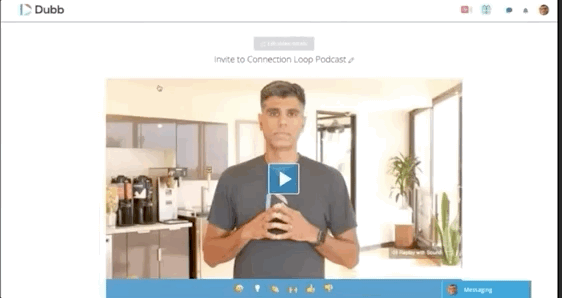
Below that video is a direct integration to my calendar. Dubb has integrations with many of the most popular calendar services, including Calendly, Book Like a Boss, Acuity Scheduling Calendar, and more.
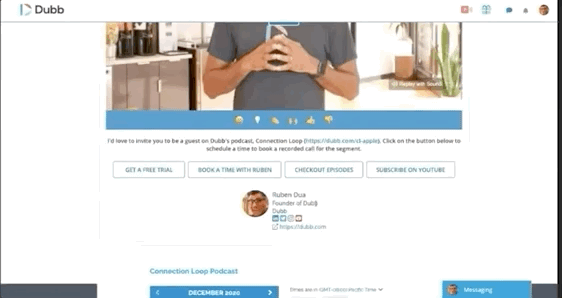
As for Connection Loop, I delegate coordination to Naomi, who is a Dubb team member. She does an outstanding job in both finding guests and guiding them through the booking process. Naomi finds potential guests based on certain criteria. People like business leaders, influential thought leaders, and potential customers are fair game. Ultimately, we want to find people with something interesting to say. Naomi sends both an email and LinkedIn message to that prospect. That LinkedIn message will contain the Dubb action page with both my video pitch and the direct calendar integration.
Before booking a time on my calendar, however, most people do a little research. They often go to the Apple Podcast page for Connection Loop and see that I have over 150 episodes and have interviewed many fascinating people. Once they are sold on the show, they can directly book a slot that is both convenient for both of us.
The booking form on my Dubb action page contains several important fields. All of the fields help my team and I get the most out of the podcast episode. They include:
- Full name.
- Email address.
- Whether the guest created a Dubb account. We do this because we use Dubb as a platform to share mini-clips from the episode. We also use this as a monetization strategy. We want everyone to check out Dubb, so this is an opportunity for our podcast guests to do so. Through this method, we have had dozens of podcast guests become Dubb users.
- The guest’s favorite topics to discuss.
- The proposed title of the podcast. 98 percent of the time, we stick with the guest’s proposed title.
- The guest’s Twitter account.
- Any high volume or niche hashtags that we can use to drive attention to the episode.
- Email address used to create the guest’s free Dubb account.
- The guest’s cell phone number. This is for text reminders. Ultimately, we want to avoid guests that have agreed to appear, yet aren’t able to at the last minute.
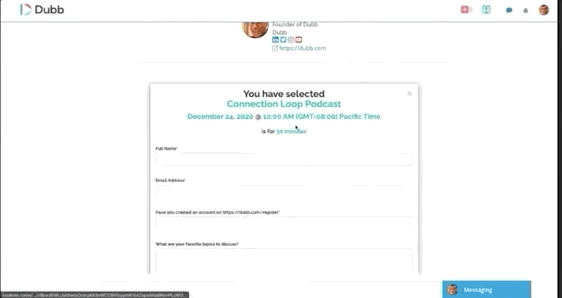
Once the guest completes the form, he or she receives an email notification. This is a fully automated process and the email reminds the guest of the interview time and some prerequisites before the interview. Sometimes, guests don’t respond, so we need to follow-up a few times. But along with this, Naomi adds all of this background information into my calendar. She also adds some key reminders (like ensuring the audio is good and that my webcam is turned on).
As you can see, this is both an automated and manual process. However, we have found that it is both convenient for the guest and helps us avoid mistakes. You should plan for something similar as you are thinking about how to start a business podcast.
Coordination Tools
There are several important tools that we use throughout the coordination process.
As mentioned above, Dubb is one of those key tools. By becoming a Dubb user, you can easily create an introductory podcast video and a direct calendar booking page. No matter the calendar service that you use, we are confident that we have an integration for it. Leveraging a Dubb action page this way lets you easily book podcast guests at scale.
Beyond Dubb, we like using Asana for our project management. My team and I enjoy its flexibility. Asana has a great free plan if you are interested in checking it out. If you don’t like Asana, there are great project management alternatives (like Monday.com or Basecamp). Trello is another great project management tool. Using Trello, you can see all of your tasks in an aesthetically pleasing way. One of the benefits of visual project management is that you can see your complete and ongoing tasks in an entirely different way. If you’d like, you can even use an Excel spreadsheet for your project management needs. Whatever it is, make sure that you are keeping track of your ongoing work in an organized way.
As for the meeting platforms themselves, you also have many choices. One of your most natural choices will be Zoom. We’re all familiar with Zoom and its live-streaming capabilities. That said, many people don’t know that you can take a Zoom meeting and broadcast it to social platforms like Facebook or YouTube. There is no simultaneous broadcasting, however, so you’ll have to make a choice here.
At Dubb, I recommend using Streamyard. Streamyard is another service that lets you easily create professional live streams. Not only that, but Streamyard lets us schedule a live video and then broadcast it to many different social platforms at the same time. Using Streamyard, we can stream Connection Loop episodes to places like Dubb’s Facebook page and Dubb’s YouTube page. Ultimately, it is an extremely versatile tool. If you are interested in checking out Streamyard, go ahead and click on our referral link (dubb.com/streamyard).
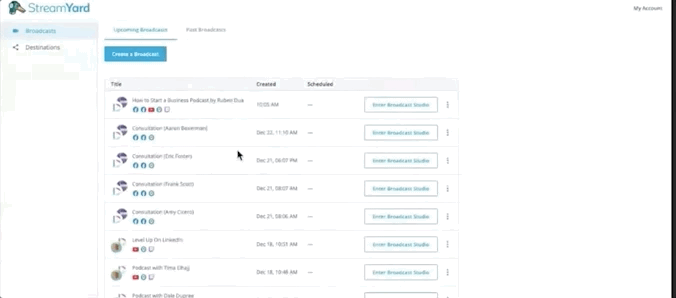
Recording
At this point of discussing how to start a business podcast, we have taken a comprehensive tour of both branding and collaboration. This question of how to start a business podcast certainly requires you to think about how you are going to brand your show and how you are going to collaborate with others. The work doesn’t stop there, however. You need to actually record your episodes. In this section, we are going to discuss some important things to keep in mind as you are recording episodes with your guests.
Best Practices for Recording
When recording, you are obviously going to need some type of podcasting equipment. Yet while it is easy to obsess over technology, the fact of the matter is that good enough is perfectly fine. You don’t need to get the fanciest and most expensive equipment as you are thinking about how to start a business podcast.
For example, for Connection Loop, I use a Blue Yeti microphone. It’s a high-quality, yet inexpensive microphone that gets the job done. It’s not a hyper-cardioid microphone if you are on the more technical side. However, for the vast majority of podcasters, the Blue Yeti is an excellent choice. As with any microphone, it’s important to monitor your levels to make sure they aren’t too high.
Beyond microphones, I use a Logitech HD 1080p webcam to record video. The best part of my setup is the gyroscopic arm. It offers me lots of versatility when I’m recording. For instance, if I want to stand up and record an episode, I can easily do so. While this isn’t a mandatory purchase, you may want to consider it if you want more flexibility.
Critically, nothing in my setup is wireless. I don’t rely on WiFi. The podcast has a USB microphone, the webcam has a plug, and even my Internet isn’t wireless. My computer connects directly to my modem. I do this because WiFi isn’t perfect. Again, you don’t necessarily need to do this, but I have found it to be a more reliable and secure way of recording my episodes.
Live vs. Edited Recordings
From some basic tech, let’s now shift gears and discuss the recording process.
Like I mentioned above, you’re likely going to want to use Zoom or Streamyard to record your episodes. Using Streamyard, for instance, you can simultaneously stream to many different social media platforms. That said, you may be wondering why you should record and stream live podcasts in the first place.
This isn’t a hard and fast rule. There are plenty of great podcasts that rely on edited recordings. However, I believe that there is some forced accountability when video streaming your episodes. When you record a video and download it, it needs to go through an editing and distribution process. While this does take time, you may feel uncomfortable going live because you may make a mistake.
Yes, it is safer to do a private, recorded session that you can edit later. There will be fewer mistakes in your episodes. However, it requires so much time, and the delay that inevitably happens makes your podcast not as much of a live experience. Along with this, recording live videos maximizes the sharing effect. Right after the episode is recorded, you can immediately share the link with the guest and start marketing the conversation. Another benefit is that you can build your audience while you are recording. You can open up the conversation to comments which can be addressed by you and the guest during the episode. Audience members can also like and engage with your conversation, which can highlight your show to your audience’s contacts and followers. Ultimately, it’s a cool way of including your audience in the overall experience.
In the end, the risks of doing a live stream are minimal and the upside is substantial. If you are still uncomfortable, however, a middle ground is to record the live stream and then edit that recording for a future release date. The edited version can be a cleaned-up version of your conversation. It can even include music and other edits. As you are thinking about how to start a business podcast, consider this alternate strategy.

Recording Etiquette
When recording your episodes, remember that your recordings are only awkward as you make them. Especially if you are streaming live, you may have to navigate around real life. Your child may walk into the room when you’re recording or your Internet may give out.
If this sort of thing happens, go ahead and embrace it. Make these interruptions and disruptions part of your story. If you don’t, you are going to feel uncomfortable and anxious. The great news is that these interruptions and disruptions make you authentic. They show that you are human (just like your audience) and that you don’t take yourself too seriously. This idea of brutal honesty can liberate you and help you record better episodes.
When you are speaking with your guest, make sure that you are paying attention to the details. Slow down, listen, and pay attention. It can be difficult, as you are trying to listen, monitor your levels, think of your next question, and handle a whole host of other issues. While you may get distracted, always circle back to your guest and what he or she is saying. Your guest is your north star when you are recording any episode.
In terms of timing, the sweet spot is an episode that is around 15 to 25 minutes long. You can go for 30 minutes if you’d like. Beyond that, however, I think that you should have a good reason to do so. Not only does it get long for your guest, but it is easier for your audience to tune out. Yes, there are people like Joe Rogan that speak with their guests for two or three hours, but they are extremely rare. It’s better to follow the tried and true path on this issue.
Finally, make sure that you are sharing your guests’ world with your audience. By this, I mean that you are giving back to your guest at the end of the episode. Circling back to my Dubb action page, one field of the form asks for guests’ LinkedIn information. This is so I can promote a particular guest’s LinkedIn when the episode wraps up. I also reference the guest’s website, book, or other things that they may want to promote.
I believe that you have to give. It is all about the giving, whether you are interviewing a guest on your podcast or solving a problem in your customer’s life. Giving lets us build strong relationships and helps us get that much closer to our professional goals.
Distribution
To wrap up this post on how to start a business podcast, I want to talk about distributing your show. Recording your episode isn’t enough. You may have the most compelling and valuable episode, but if no one listens to that episode, its effect will be greatly diminished.
Social Posting
The first point to discuss is posting your episodes on social media. Social media is one of the most effective distribution channels out there. It is essentially free and can have a massive reach.
When sharing your episodes on social media, have a bias toward quick distribution. You don’t want your episodes sitting on your hard drive for two or three weeks. Instead, you want to get it on social media sooner rather than later. This is especially true if your episode contains time-related content. Even if the content is evergreen, distributing quickly lets you get your episode in the hands of your audience. It’s extremely exciting when you do this because you never know how an episode is going to be received. If you have a real hit on your hands, you have more time to greater traffic and engagement from it.
As for the platforms that you use, the choice is yours. You will definitely want to upload your videos to YouTube, as it has immense reach. Social networks like Facebook, Twitter, and even Twitch are also great options. Even if you are recording video of your show, you will also want to take the audio files and upload them to the most common podcast directories (like Apple Podcasts and Spotify). This is a great start, but you will also want to consider other distribution channels as necessary.
Finally, when you are done recording your episodes, make sure that you are immediately sharing the episode links with your guests. This lets your guest quickly share the episode with his or her audience, thereby helping spread the word about the episode and your show as a whole.
Releasing Micro-Content Through the Waterfall Method
One outstanding way to distribute and promote your show is to leverage Dubb’s Waterfall Method. The Waterfall Method is an excellent way to get multiple pieces of content out of a longer piece of content (like a podcast episode).

The Waterfall Method starts with that long-form content. It can certainly be one of your podcast episodes, but it can also be things like a webinar that you recently spearheaded. Once you have that piece of long-form content, you can cut that content into smaller and smaller bits of information. It is an outstanding way to get lots of content out of one long discussion. Those micro pieces of content are easily shareable on everything from your Facebook and Twitter pages to even Instagram and TikTok.
At Dubb, we have an editor named Bono who listens to every podcast episode and finds three to six micro-clips. These micro-clips are the punchiest clips that are in the episode. In other words, they are the most likely to pique our audience’s interest and convince them to download or listen to the entire episode. Once he finds those clips, Bono trims and cuts those clips to make them as quick and concise as possible. For instance, he finds a two-minute clip and trims it down to a 60-second clip. On each clip, Bono puts a title on the top, a brief description of the clip at the bottom, social links, and then the captions for the clip. The captions are especially important. Even if viewers can’t listen to the audio, they can read the captions and consume the specific micro-clip.
To make these micro-clips, you can leverage a wide range of tools. Wave.video and Kapwing are two great options, but you don’t need to use them if you have some other favorite video editing tool. At Dubb, we custom built our micro-content template in Adobe Premiere and Adobe After Effects. By including the subtitles and our Dubb branding on each piece of micro-content, we can both educate our audience and remind them about Dubb. We use Rev.com to generate the captions for each piece of micro-content.

Finally, we choose to include a custom thumbnail on every piece of micro-content. It isn’t a huge thing, but this custom thumbnail lets us choose what our audience first sees when finding this piece of content. By actively choosing the thumbnail, we increase our odds of audience members actually clicking on the video and consuming our content.
Ultimately, by using micro-content, we can consistently engage with both our audience and the guest’s audience. Your guests and their followers are going to want to organically share your clips with their audiences. A chain reaction starts and you’re able to get much more visibility for your content. No matter the size of your audience or the content of your show, I highly recommend that you capitalize on the Waterfall Method. It is one of the best ways to market your business podcast.
Miscellaneous Marketing Advice
Marketing a podcast isn’t always the easiest thing. It’s one of the more forgotten elements when thinking about how to start a business podcast. While you will constantly need to think about ways to reach your audience, there are several important first principles to keep in mind.
First, don’t hesitate to start small when building your audience. If you are starting a brand new show, your first listeners will likely be your friends and family. You may also have some repeat customers or key prospects tuning in. There’s nothing inherently wrong with this. All of us need to start somewhere. For your first hundred or so episodes, the goal should be to build relationships. While you may have high expectations for your show as a whole, you need to manage your expectations in the beginning. Even though you may not see progress as quickly as you’d like, you need to stay consistent and build your podcast brand. Eventually, your audience will substantially grow, so stick with it.
Next, try to recognize “moments” when you are recording. “Moments” are those pieces of dialogue or conversations that stand out in your episode. They can be a key insight that your guest shared or a non-traditional view on an important issue in your industry. When those moments occur, try to make a mental note of them. Better yet, when you are recording the episode, write down the approximate minute mark of those moments.
By doing this, you can make your life easier in the editing and marketing process. Instead of searching through the episode to find compelling clips to create, you can quickly look at your notes and find those moments. Then, you or a colleague can cut clips of those moments and distribute them on social media.
Yes, it takes some focus on your part. You need to facilitate the discussion and note those awesome moments at the same time. That being said, it’s in your interest to multitask here. The more you do it, the more you will get better at it. Even if it’s just marking the minute and second of a particular moment, you will become more efficient and create content that is more compelling and shareable.
Next, let’s talk about social media ads. If you are posting your podcast’s micro-content on platforms like Facebook, you have the option of using sponsored posts to promote your content. As you likely know, this means that you will pay a certain amount of cash to elevate your content to a target cohort. Social media ad targeting, especially on Facebook, can be extremely powerful. If you are trying to introduce your content to a new subset of people, social media ads can be an effective way to do so.
That being said, there isn’t a free lunch here. Social media ads can become quite costly. The good news is that these social media giants offer advertising opportunities for virtually any budget. You’ll certainly need to do some more diligence to determine if this opportunity makes sense for you. That being said, recognize that it is available—so long as you are willing to spend cash to make it happen.
Last (but not least), there is a small, yet important point related to marketing on social media. Whether you are posting organic or paid content on social media platforms, make sure that you are not putting a link to your podcast in the caption. Social media algorithms do not favor posts containing outbound links. In other words, they want to keep their users on their platforms.
One alternative is to put your podcast link in the first comment to your post. That way, your audience can see the link and you won’t be punished by algorithms. After some time, you always have the option of going back and putting your link in the original caption, but that is up to you.
The Opportunity At Your Fingertips
Starting a business podcast can be incredibly exciting. From interacting with amazing guests to building brand recognition, there are plenty of opportunities here. But as you can see, this question of how to start a business podcast may be more nuanced than you initially thought. There are many moving parts—some of which can make the difference between failure and success.
All of that said, following the insights and principles discussed here can maximize your odds of success. By working hard, staying consistent, focusing on providing value for your audience, and spreading the word about your show, you are bound to achieve all of your podcasting goals.
As you go on your podcasting journey, I also recommend that you check out Dubb. Dubb can not only help you create Dubb action pages, but it can be a true asset as you are marketing your show. To learn more about Dubb, click here. You can also click here to sign up for a free 14-day trial.

